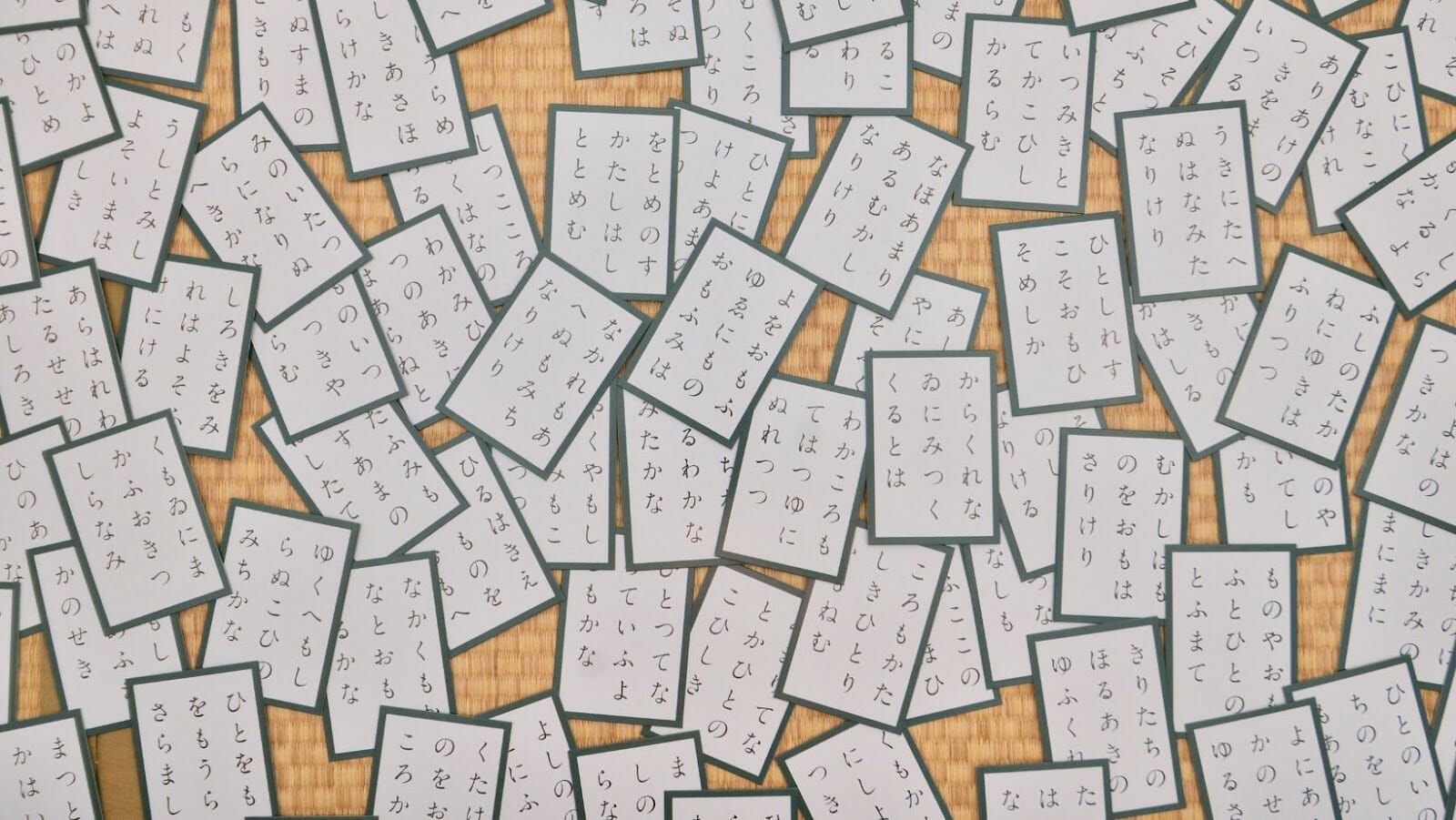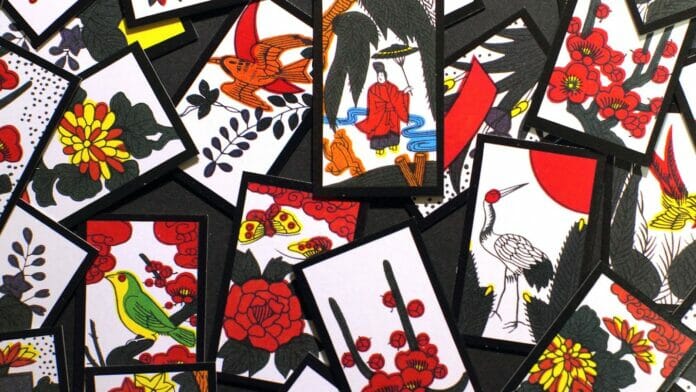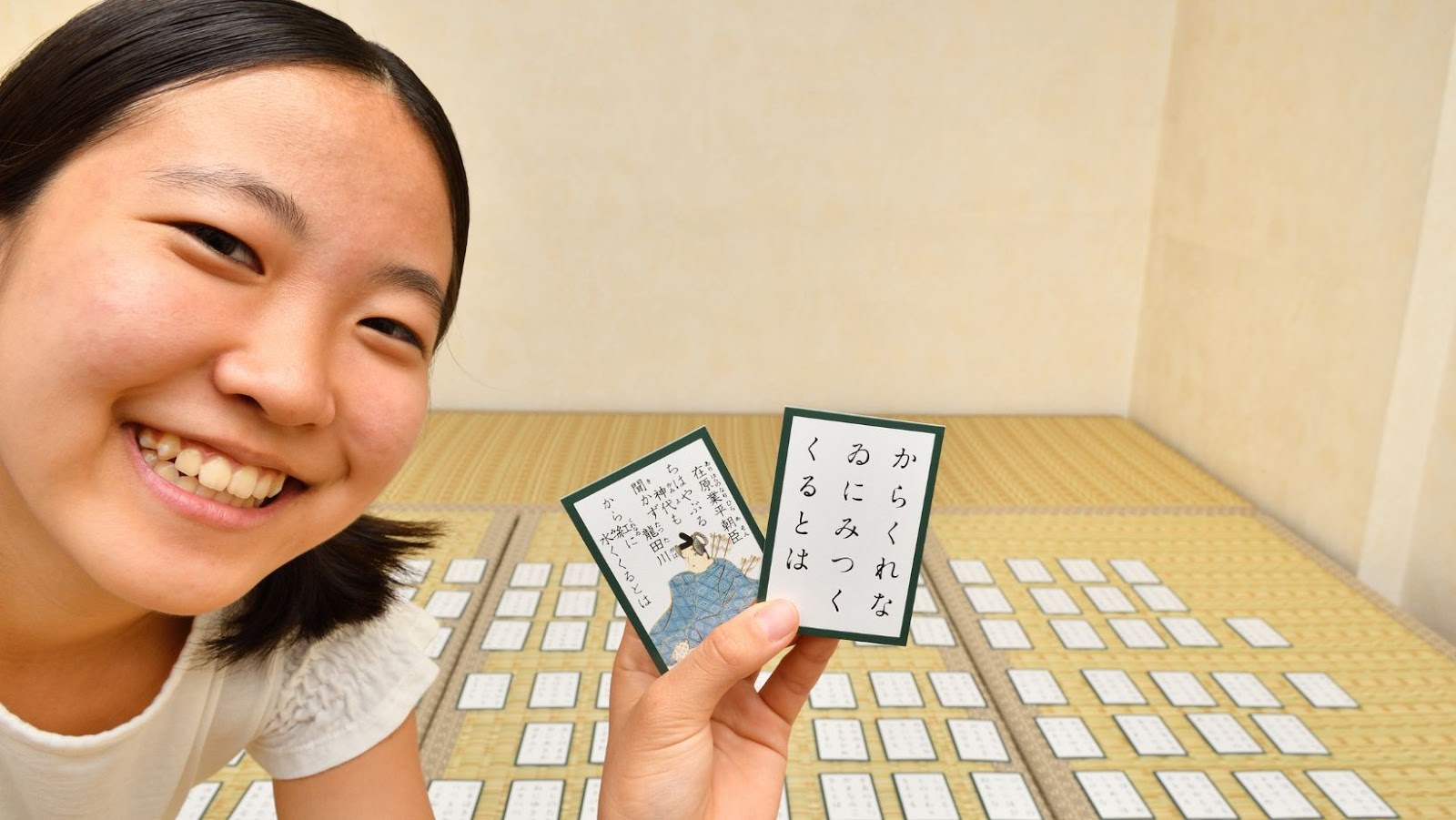Card games are a part of Japan’s culture, and have been around since the Heian Period (794-1185 AD). During the Edo Period (1603-1867 AD), card games became even more popular, as the numerous daimyo (warlords) of the time had these card games played in their courts.
This article will provide an overview of the history of Japanese card games, detailing their origins and how they have evolved over the years.
Early Japanese Playing Cards
Japanese card games have a rich and fascinating history that dates back to the early 17th century with the introduction of karuta, or Japanese playing cards. These cards were created to teach poems to Japanese children, but they eventually became a popular entertainment form for adults.
In the 18th and 19th centuries, various other card games emerged in Japan, including hanafuda, a game that uses cards decorated with flowers and plants, and kabufuda, which uses cards with numbers and suits.
Despite the changes in Japanese society and culture over the centuries, these card games have retained their popularity. People of all ages and backgrounds enjoy them to this day.
Pro tip: If you want to learn more about Japanese card games, try playing them with a local gaming group or club. It’s a great way to learn about the history and culture behind these games while having fun and making new friends.
Types of Playing Cards in Japan
Playing cards have a rich history in Japan, dating back to the 16th century when Portuguese traders introduced them. Two types of playing cards commonly found in Japan are Hanafuda and Kabufuda.
Hanafuda cards, or flower cards, have 48 cards, each representing a different flower. This type of playing card is used in traditional Japanese games like Koi-Koi and Hachi-Hachi.
Kabufuda cards have a unique design, with one end being blank and the other featuring a kabuki actor, historical figure, or Japanese poem. This type of card is used in gambling games like Oicho-Kabu and Kakkuri.
Throughout history, Japanese card games have been a popular pastime, enjoyed by people of all ages and social classes. Many traditional games are still played today, and new games continue to be created, combining traditional and modern elements.
Japanese Hanafuda Cards
Hanafuda cards originated in the late 18th century and are traditional Japanese playing cards. They are typically made from sturdy paper or cardboard and come in a deck of 48 cards split into 12 suits. Each suit represents a month of the year and has a distinct design based on seasonal flowers, plants, or animals.
The origins of Japanese card games can be traced back to the introduction of Western playing cards in the mid-16th century by Portuguese traders. These cards, known as “Portuguese cards” or “nanban karuta”, differed from traditional Japanese cards as they featured exotic images and symbols from foreign cultures.
Over time, Japanese card games evolved into their unique style, with Hanafuda cards being one of the most popular. The cards are used in traditional Japanese games, including Koi-Koi, Hanafuda-Gassen, and Hachi-Hachi. Today, they are still played and enjoyed by people of all ages in Japan and worldwide.
Bushocard/2702本願寺蓮如
Japanese card games have evolved, becoming more varied and complex. As a result, they have gained in popularity domestically and internationally, with people worldwide taking part in tournaments and playing casually with friends.
This article will examine the history of Japanese card games, from their beginnings over a hundred years ago to the popular games played today.
Adaptation and Popularity of Hanafuda Cards
Hanafuda cards are a unique set of Japanese playing cards that have been popular for centuries. These cards feature beautiful floral designs and are used in a variety of games in Japan.
The origin of Japanese card games can be traced back to the 16th century when imported Portuguese playing cards were introduced to Japan. Over time, Japanese card games evolved to include unique features such as hanafuda cards, which were created in the late 18th century.
The hanafuda deck consists of 48 cards, divided into 12 suits representing the months of the year. Each suit features a different flower or plant; some suits have additional cards depicting animals or other symbols.
Hanafuda cards have become a popular part of Japanese culture, featuring in traditional games such as Koi-Koi and Hachi-Hachi, as well as modern games and video games. In addition, their unique design and history have made them a fascinating aspect of Japanese card games, attracting players worldwide.
Pro tip: If you want to learn more about hanafuda cards and Japanese culture, try playing a traditional game with locals on your next trip to Japan.
Influence of Western Cards on Japanese Card Games
The introduction of Western cards to Japan in the 16th century significantly impacted the evolution of Japanese card games.
Before Western cards, Japanese card games consisted of hanafuda, small cards made from stiff paper or cardboard decorated with floral designs. However, with the arrival of playing cards from the West, Japanese game makers began incorporating these new designs and gameplay elements into their games.
This led to the creation of new games, such as daifugo and baba-nuki, combining elements of traditional Japanese and Western card games.
Today, Japanese card games evolve and adapt, creating new variations and styles yearly. The history of Japanese card games is a testament to the power of cultural exchange and the influence of globalization on game design.
Development of Traditional Japanese Card Games
Japanese card games have a rich history that dates back to the Heian period (794-1185). Karuta, Hanafuda, and Uta-Garuta are some of the most popular traditional Japanese card games that have evolved.
Karuta cards were originally used for teaching poems and stories but eventually became a popular competitive game. Players must quickly grab the card that matches the poem read aloud from the “reader” card.
Hanafuda cards are made up of flower and plant suits, and have been used for many games since the mid-17th century. The most popular game played with Hanafuda cards is Koi-Koi, where players try to capture cards worth the most points to win.
Uta-Garuta is a card game based on poetry. One person reads a line from a poem, and the players must race to pick the corresponding card to complete the poem. Uta-Garuta was invented in the 17th century and is still popular today.
The history of Japanese card games reflects Japanese culture and tradition and can offer an interesting insight into this rich and ancient civilization.

Bushocard/1939真田の饗宴
The history of Japanese card games can be traced back to the 17th century, when card games were played mainly as recreational activities. Since then, they have played a key role in many aspects of Japanese society including entertainment, education, and social bonding.
In this article, we will explore how card games have impacted the country’s cultural and social landscape, and their significance today.
Card Games for Gambling and Betting
The history of Japanese card games dates back to the 16th century and has played an important social role in Japanese society for centuries. Japanese card games were originally designed for entertainment and have evolved to become an integral part of Japanese gambling and betting culture.
Some popular Japanese card games played for gambling and betting include:
Hanafuda: This game uses 48 cards with images such as flowers, animals, and numbers. Players form combinations of cards to score points and win the game.
Mushi: This game is similar to poker, using 40 cards with different suits and ranks. Players bet on the strength of their hand and compete to have the highest-ranking set of cards.
Koi-Koi: This game is played with Hanafuda cards and involves creating cards corresponding to different seasons and flowers. Players bet on who can create the most sets during the game.
In addition to entertainment and socialization, Japanese card games have also been used to teach moral values and skills such as patience, strategy, and decision making.
Cultural Significance of Card Games in Japan
Japanese card games have a rich history and cultural significance in society, being used for various games and pastimes. The history of Japanese card games goes back centuries, with the earliest card games believed to be introduced during the 16th century.
Today, Japanese card games are still popular and played in different settings. One such game is Karuta, a traditional card game played with 100 unique cards featuring images and Japanese poems. This game is usually played during New Year’s celebrations and is also played competitively.
Another game of cultural significance is Hanafuda, which features images inspired by nature and is played as a gambling game. Hanafuda has been associated with the popularization of Nintendo as a company, as it was their first successful product.
In addition to being a form of entertainment, Japanese card games have also taught children about different aspects of Japanese culture, traditions, and values.
The cultural significance of Japanese card games is undeniable, reflecting the country’s love for games and the importance of community and social interaction.
Use of Card Games in Traditional Festivals and Celebrations
Card games have played a significant role in Japanese society for centuries, particularly during traditional festivals and celebrations. The history of Japanese card games can be traced back to the 16th century when a new trend of trading card games began in Japan.
Hanafuda, a traditional Japanese card game, emerged during the 18th century and became immensely popular during Edo. It features 48 cards, each representing a month of the year with different flowers and plants. Hanafuda is played various ways during New Year celebrations, including a gambling variant called Hana-Awase.
Karuta is another popular Japanese card game that involves memorization and reflexes. It became widespread in the early 20th century and is usually played during the New Year or cultural events. Players must quickly identify and grab cards matching a poem or phrase invoked by a reader.
Using card games in Japanese festivals and celebrations reinforces their social and cultural significance while providing entertainment and promoting community cohesion.
Bushocard/2962丹羽長秀
Card games have been enjoyed in Japan for centuries, from the earliest games like ‘Koi-Koi’ to the more recently popularized ‘Hikaru no Go’ and ‘Yu-Gi-Oh!’. Different card games have become beloved over the years, as each has unique rules and strategies.
Let’s dive into some of history’s most popular and beloved Japanese card games.
Karuta – The Japanese Poetry Card Game
Karuta is a traditional Japanese card game that originated in the Heian period (794-1185). The game typically consists of two sets of cards, each featuring classical Japanese poetry.
The history of Japanese card games dates back to the 16th century when playing cards were brought to Japan from Portugal.
Over time, Japanese people adapted the Portuguese-style cards to create unique games with themes and artistic styles.
The popularity of Japanese card games increased in the Edo period (1603-1868) when people from all social classes used them to pass the time and socialize.
Today, many Japanese card games, including Karuta, Hanafuda, and Trump-based games like Uno. These card games are still popular among Japanese people of all ages and are increasingly gaining popularity among people worldwide who are interested in Japanese culture.
Pro-tip: If you’re a fan of card games, learn to play Karuta from a Japanese friend or join a local Karuta club to enhance your Japanese cultural experience.
Hanafuda – The Japanese Flower Card Game
Hanafuda is a traditional Japanese card game that originated in the 18th century. It consists of a deck of 48 cards divided into 12 suits, each representing a month of the year and a different flower. The game is played with a unique set of rules and has been an integral part of Japanese culture for centuries.
Japanese card games have a rich history that dates back to the 16th century, where they were developed in response to the prohibition of gambling-related activities. These games were simple and often had a moral or educational purpose, such as teaching children math or reinforcing social values.
Over time, Japanese card games evolved, and new games were invented, reflecting changes in society and culture. Today, Japanese card games are enjoyed by people of all ages and are an essential part of Japanese gaming culture.
Pro Tip: If you want to experience the unique thrill of Hanafuda, look for a traditional deck online or at a Japanese specialty store, and gather some friends to learn the game.
Kabufuda – The Japanese Trump Card Game
Kabufuda is a traditional Japanese trump card game played with small decks of cards that originated during the Edo period. The cards are smaller and thicker than Western-style playing cards, and they feature colorful designs of symbols representing flowers, animals, and other objects.
Japanese card games have a rich history that dates back to the 16th century when Portuguese traders introduced Western-style playing cards to Japan. Over time, the Japanese adapted these cards to create unique games that reflected their culture and traditions. From there, the popularity of card games spread throughout the country, and new games and variations emerged into mainstream culture.
Some of the most popular Japanese card games include Hanafuda, a colorful game with striking imagery of nature, and Karuta, a fast-paced game that requires quick reflexes and memory skills.
Today, Japanese card games are enjoyed by people of all ages and are an important part of the country’s cultural heritage.

Bushocard/2066片倉小十郎
Japanese card games have been around for centuries, and their influence has spread worldwide. From traditional Japanese games like Karuta and Hanafuda to the modern phenomenon of Yu-Gi-Oh, card games have created an engaging, interactive form of entertainment and competition.
In this section, we’ll look at the history of Japanese card games and how they have impacted the world.
Global Influence of Japanese Card Games
Japanese card games have had a significant global influence, with many popular games originating from Japan and now enjoyed by people worldwide. The history of Japanese card games dates back centuries, with early games being handmade and featuring hand-drawn designs.
One of the oldest and most popular Japanese card games is Hanafuda, which translates to “flower cards” and features beautiful artwork inspired by nature. Another popular game is Karuta, a competitive game that involves quickly grabbing cards with specific images or phrases on them.
In recent years, Japanese trading card games like Pokemon and Yu-Gi-Oh! have become a global phenomenon, with millions participating in tournaments and competitions worldwide. These games feature complex rules, strategic gameplay, and intricate artwork that has captured the imagination of gamers of all ages.
The impact of Japanese card games on the world is undeniable, with their influence continuing to grow as new games are developed and introduced to audiences worldwide.
Examples of Japanese Card Games in Pop Culture
Japanese card games have been making waves in pop culture for many years. Examples of popular Japanese card games in pop culture include Pokemon and Yu-Gi-Oh! In addition, these card games have spawned anime TV shows, movies, video games, and merchandise worldwide.
Japanese card games have a rich and storied history dating back to the 16th century. Hanafuda, a traditional Japanese playing card game, was created during this time and has remained widely popular for centuries. However, in the 1900s, Western-style cards were introduced to Japan, and the Japanese people began to adapt and create new card games with their unique cultural twist.
Today, Japanese card games are popular and influential in gaming and pop culture. They have even inspired the creation of new card games and game mechanics.
Pro Tip: Try exploring different cultures’ traditional games to learn more about their history and unique forms of entertainment.
Modern Adaptations of Traditional Japanese Card Games
Japanese card games have a rich history and have been enjoyed for centuries. These games continue to evolve and adapt, creating new and exciting experiences for players worldwide.
Traditional Japanese card games like Karuta and Hanafuda have existed for over 500 years, and their popularity shows no signs of waning. Modern adaptations of these games have been introduced in recent years, bringing their unique gameplay and aesthetics to a new generation.
For example, WIXOSS is a popular Japanese collectible card game that combines elements of strategy and role-playing games. It has achieved international acclaim with worldwide competitive tournaments held to this day. Hanafuda Koi Koi is a mobile adaptation of the traditional Japanese game Hanafuda. Its charming and nostalgic graphics among Japanese and non-Japanese audiences have gained popularity globally.
Through these modern adaptations of traditional Japanese card games, people worldwide can enjoy Japan’s rich history and culture while creating new and exciting experiences.



